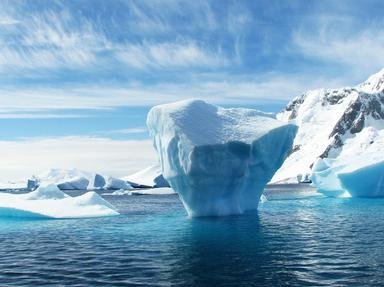Quiz Answer Key and Fun Facts
1. At over 82 degrees latitude, this village in Canada is the most northern inhabited place in the world, and well north of the Arctic Circle. It was named after an English ship that had spent the winter near there during 1875-76. In what cold place are we turning blue?
2. Off to a larger town north of the Arctic Circle, at over 71 degrees latitude. This one is in the US, where it has the honor to be known as the most northern community. It is located on the Chukchi Sea and was named after a geographical point that was named for a member of the British admiralty in 1825. Where are we in our long-johns now?
3. Now we're going to a settlement, named for the American head of a coal company, that's in a group of islands above 78 degrees latitude. Mr. Longyear founded both the town and the coal mine which was the first one in the area. Although mining is still the main business in this area, tourism is starting to catch on in Svalbard. In what country are we shivering now?
4. We're off to a city above 68 degrees latitude that is the largest city north of the Arctic Circle, although its population is declining from its high. In both World War I and II the Allies shipped goods and raw materials to this city to help the Russians. In 1941 the Germans included the city in Operation Silver Fox but were not successful in capturing it. In what city are our teeth chattering now?
5. We're warming up a bit by going to only a little over 60 degrees of latitude to the capital of one of the Nordic countries. It is also the largest city of that country which boasts a blue on white flag. In what city are we defrosting somewhat?
6. Now, back to the very cold climes again, this time to a bit over 70 degrees latitude. We're going to an unincorporated US working town that was developed as facilities for employees of companies that work nearby. We can get there via plane or on the Dalton Highway, a road that has been shown on a popular television show. The town didn't really get going until 1967 when oil was found in good supply. What very cold place are we staying...for only a little bit?
7. Let's warm up just a bit and go to about 67.5 degrees latitude where we'll find the northernmost city in Sweden, that was founded in 1900, although archaeological remains prove that the area around it has had people living in or nearby for at least 6,000 years. Although iron ore was known to be in the area, because it was so hard to get to, the weather so harsh, and the ore so high in phosphorus, it simply wasn't worthwhile to mine. Eventually, in 1903 the railway was opened and the mining could commence. Where are we, getting chill blains?
8. We're going "south" to warm up for awhile, all the way to just a little over 60 degrees latitude, to the largest city in Canada's Yukon Territory. Since it's built in a river valley, the weather is somewhat warmer than the surrounding areas. On what river, which is in the Bering Sea watershed, is this city built?
9. Now we'll move back north to a bit over 61 degrees latitude, to a town whose name translates to "little hammer" with a spring, 2011, population of a little over 26,000 people. In 1994 it hosted the Winter Olympics. Where are you getting ready to ski?
10. Before leaving the cold area of the world, we'll end up at a little over 64 degrees latitude in a city with a population of about 120,000 before counting outlying areas, that is the largest city as well as capital of its country. In fact, Wiki says it is "the world's northernmost capital of a sovereign state". Where will be saying good-bye cold weather?
Source: Author
habitsowner
This quiz was reviewed by FunTrivia editor
spanishliz before going online.
Any errors found in FunTrivia content are routinely corrected through our feedback system.


